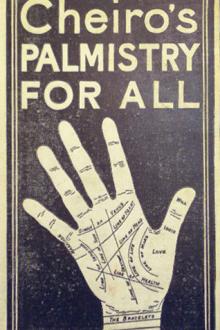Palmistry for All by Cheiro (free reads TXT) 📕

- Author: Cheiro
- Performer: -
Book online «Palmistry for All by Cheiro (free reads TXT) 📕». Author Cheiro
The study of these corpuscles was also taken up by Sir Charles Bell, who, in 1874, demonstrated that each corpuscle contained the end of a nerve fibre, and was in immediate connection with the brain. This great specialist also demonstrated that every portion of the brain was in touch with the nerves of the hand and more particularly with the corpuscles found in the tips of the fingers and the lines of the hand.
The detection of criminals by taking impressions of the tips of the fingers and by thumb marks is now used by the police of almost every country, and thousands of criminals have been tracked down and identified by this means.
To-day, at Scotland Yard, is to be seen almost an entire library now devoted to books on this side of the subject and to the collections that the police have made, and yet, in my short time, I remember how the idea was scoffed at when Monsieur Bertillon and the French police first commenced the detection of criminals by this method. If the ignorant prejudice against a complete study of the hand were overcome, the police would be greatly assisted by studying the lines of the palm, and acquiring a knowledge of what these lines mean, especially as regards mentality and the inclination of the brain in one direction or another.
It is a well-known fact that, even if the skin be burned off the hands or removed by an acid, in a short time the lines will reappear exactly as they were before, and the same happens to the ridges or "spirals" in the skin of the inside tips of the fingers and thumb.
The scientific use of such a study could also be made invaluable in foreseeing tendencies towards insanity, etc.
Sir Thomas Browne, in his Religio Medici, after referring to Physiognomy, says:
"Now there are besides these characters in our faces certain mystical figures in our hands, which I dare not call mere dashes, strokes à la volée or at random, because delineated by a pencil that never works in vain, and hereof I take more particular notice because I carry that in mine own hand which I could never read nor discover in another."
But prejudice is a hard thing to combat, and, in consequence, a study which could render untold aid to humanity has been neglected in modern times. Yet it cannot be denied that this strange study was practised and followed by some of the greatest teachers and students of other civilisations.
Whether or no these ancient philosophers were more enlightened than we are has long been a question of dispute, but the one point and the most important one which has been admitted is, that in those days the greatest study of mankind was man. It is, therefore, reasonable to suppose that their conclusions are more likely to be correct than those of an age like our own—famous chiefly for its implements of destruction, its warships, its dynamite, and its cannon.
This study of hands can be traced back to the very earliest, most enlightened forms of civilisation. It has been practised by the greatest minds in all those civilisations, minds that have left their mental philosophies and their monuments for us to marvel at. India, China, Persia, Egypt, Rome—all in their study of mankind have placed the greatest store in their study of the hand.
During my stay in India, I was permitted by some Brahmans (descendants of the Joshi Caste, famous from time immemorial for their knowledge in occult subjects) with whom it was my good fortune to become intimately acquainted, to examine and make extracts from an extraordinary book on this subject which they regarded as almost sacred, and which belonged to the great past of the now despised Hindustan.
As the wisdom of the Hindus spread far and wide across the earth, so the theories and ideas about this study spread and were practised in other countries. Similar to the way in which religion suits itself to the conditions of the country in which it is propagated, so has it divided itself into various systems. It is, however, to the days of the Greek civilisation that we owe the present clear and lucid form of the study. The Greek civilisation has, in many ways, been considered the highest and most intellectual in the world, and here it is that Palmistry or Cheiromancy (from the Greek χεíρ, the hand) grew and found favour in the eyes of those who have given us laws and philosophies that we employ to-day and whose works are taught in all our leading colleges and schools.
It is a well-known and undisputed fact that the philosopher Anaxagoras not only taught but practised this study. We also find that Hispanus discovered on an altar dedicated to Hermes a book on Cheiromancy, written in gold letters, which he sent as a present to Alexander the Great, as "a study worthy of the attention of an elevated and enquiring mind." Instead of it being followed by the "weak-minded," we find, on the contrary, that it numbered amongst its disciples such men of learning as Aristotle, Pliny, Paracelsus, Cardamis, Albertus Magnus, the Emperor Augustus, and many others of note.
This brings us down to the period when the power of the Church was beginning to be felt outside the domain and jurisdiction of religion. It is said that the early Fathers were jealous of the influence of this old-world science. Whether this be true or not, we find that it was bitterly denounced and persecuted by the early Church. It has always been, that the history of any dominant creed or sect is the history of opposition to knowledge, unless that knowledge come through it. This study, therefore, the offspring of "pagans and heathens," was not even given a trial. It was denounced as sorcery and witchcraft; the devil was conjured up as the father of all such students, and the result was that through this bitter persecution, the study was outlawed, and fell into the hands of vagrants, tramps, and gipsies. In spite of this persecution it is interesting and significant to notice that almost the first book ever printed was a work on Palmistry, Die Kunst Ciromantia, printed in Augsburg, in the year 1475.
In examining this subject it will be found that in the study of mankind it came to be recognised that, as there was a natural position on the face for the nose, eyes, lips, etc., so also on the hand was there a natural position for what is known as the Line of Head, Line of Life, and so on. If these were found in some unnatural position they would equally be the indications of unnatural tendencies. It doubtless took years of study to name these lines and marks, but it must be remembered that this curious study is more ancient than any other in the world.
In the original Hebrew of the Book of Job (chap. xxxvii., ver. 7), we find these significant words: "God caused signs or seals on the hands of all the sons of men, that the sons of men might know their works."
As the student of anatomy can build up the entire system from the examination of a single bone, so may a person by a careful study of an important member of the body such as the hand, apart from anything superstitious or even mystical, build up the entire action of the system and trace every effect back to its cause.
To-day the science of the present is coming to the rescue of the so-called superstition of the past. All over the world scientists are little by little sweeping aside prejudice and beginning to study occult questions. Perhaps the "whys and wherefores" of such things may one of these days be as easily explained as are those wireless waves of electricity that carry messages from land to land.
CHAPTER II THE LINE OF HEAD OR THE INDICATIONS OF THE MENTALITYThe object of the following chapters is to give clear and unmistakable instruction on the lines and markings of the hands, both from the student's standpoint and from that of the general reader. This is not usually the course adopted in books printed on this subject which have to appeal to a general public.
During my twenty-five years' professional experience in England, America, and other countries, I have carefully noted down the questions that are not answered in books published on this subject. I have also recorded what are the difficulties that arise in the minds of those students who meet this, that, or the other mark or line and search in vain for some explanation as to its meanings. I may add that there is not a single point on which I give information that has not been proved by me from probably thousands of cases that have come before me during my own professional experience.
As regards illustrations, I have endeavoured to make these of the simplest and clearest kind possible. I have every confidence that if they are carefully studied, no student can fail to grasp this subject in a masterful manner, and that whoever acts upon the advice I give in these pages, cannot fail to become successful as an interpreter of this study.
In all my work I regard the Line of Head (page 11) or the Line of Mentality as the most important sign that can be found in the hand.
A Line of Head is like the needle in the compass, without a true knowledge of which it is impossible to grasp the "direction of the subject." I have seen more mistakes caused by a lack of grasp of this point than by anything else.
I have seen, for example, many students make the mistake of paying great attention to what looked like a good Line of Sun or Success, and, at the same time, not noticing a weak, badly formed Line of Head, which contradicted the promise of success given by the various lines. If, on the other hand, the student had first noticed the Line of Head, he would have been able to tell the subject that the promise of success was not backed up by the intelligence or the mentality.
As regards the future being foreshadowed, it has been demonstrated that the brain is always growing, changing, increasing, or diminishing. These changes commence years before the effect is shown by the thoughts or actions of the individual. A boy ten years old may at that point commence a development which will not be felt until he is thirty, and then it may change his whole life and career. As this development commences at ten, even at that age it has affected certain nerves, and they in their turn have already affected the Line of Head—a full twenty years before the point of change or action has been reached. It therefore follows that the future may be seen and told by a careful examination of the hand which, as Aristotle has said, is the "organ of all organs, the active agent of the passive powers of the entire system."
THE LINE OF HEAD




Comments (0)